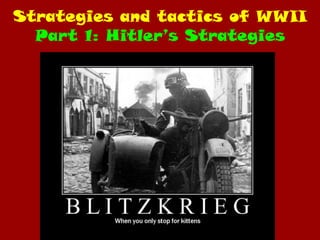
Strategies and tactics_of_wwii__hitler2
- 1. Strategies and tactics of WWIIPart 1: Hitler’s Strategies
- 2. The big picture One area for HSC questions in this topic is the aims and strategies of the Allied and Axis Powers, these questions could come in many forms for example: Evaluate the view that the air war determined the outcome of the European War. 2008 Evaluate the effectiveness of Allied and Axis strategies Evaluate the reasons for the Allied victory in WWII Any of these questions will require an understanding of the motivations and the relative success and failures of a variety of campaigns.
- 3. Part 1 – Hitler’s Strategies Hitler’s strategies and tactics continually focussed on conquest and victory at any cost. Hitler was ambitious and maintained total self belief (in many cases delusional) about his own abilities. He declared himself Oberkommando, or superior commander, of all military resources within the Third Reich. Any German General who challenged Hitler’s viewpoint would quickly find themselves demoted or moved to a position of obscurity. Many of Hitler’s ideas were born of self confidence, megalomania, rather than any justified military genius
- 4. Blitzkreig Blitzkreig (lighting war) was Germany’s highly successful battlefield tactic until the losses of 1942 (Africa/Russia) Essentially it was a combined arms approachinvolving coordination between mechanised infantry, tanks and aircraft and artillery to encircle and destroy a target quickly and move on. Aircraft were especially important in delaying reinforcements and disrupting communications and transport lines Blitzkreig was extremely effective on flat open terrain and helped Germany to defeat, Poland, France and the low countries. It was eventually defeated by intense resistance, especially in the Russian campaign. Blitzkreig’s other weakness was that it used extensive resources thus should be considered a short term strategy.
- 5. Part 1 – Hitler’s Strategies One of Hitler’s critical flaws was that he wasn’t interested in minor details such as geography and logistics. Ultimately his early successes would be the core of his undoing. The Germans could take territory but not hold it. Even successfully holding territory was costly on manpower. Norway’s army of occupation in 1944 consisted of over 400,000 troops. The allies did not need to occupy territory so were more free to choose where to fight. Soldiers need constant resupply: fuel, food, clothing ammunition and medicine. When they are not forthcoming setbacks are inevitable, Russia is one prime example. Hitler’s enemies would also create what havoc they could, even whilst losing. For example the Russian Scorched Earthpolicy starved the Germans for resources.
- 7. Fighting on too many fronts… In Mein Kampf, Hitler wrote about the dangers of fighting on too many fronts. Yet during WWII he continually broke his own rules to achieve his territorial goals. The Nazi-Soviet Non Aggression Pact should have helped Hitler reduce the need to fight on too many fronts yet he chose to attack the Soviet Union anyway. Whether by accident of design Hitler was ultimately forced to fight on three or four fronts for most of the war: Western Europe, North Africa, Russia and the Mediterranean.
- 8. The Problem with allies… As with WWI Germany’s allies in WWII were generally poor and uncooperative. The same could be said of the Allies until 1941. Italy’s army was poorly trained and equipped compared to the German army, they lacked motivation and Italy’s industrial base was a poor comparison. Time and again Germany was forced to send troops to help them, even reconquering Italy after the Allies invaded. This further stretched Hitler’s forces. Japan and Germany never acted in cohesion, they essentially operated 2 simultaneous wars with little overlap. Arguably Japan’s lack of pressure on Russia made Hitler’s victory harder and their attack on the USA was ultimately significant as it brought another major power onto the allied side.
- 9. Hitler get’s emotional… Many of the poor strategic decisions that can help to explain why the Nazi’s lose the war can be blamed entirely on Hitler’s emotional choices. Consider: Hitler allows 344,000 British and French soldiers to escape at Dunkirk in the interests of peace. He then begins attacks on Britain when peace is refused. After the British drop a few bombs onto Berlin Hitler then orders a shift in strategy from military targets in Britain to civilian targets (against the advise of generals) Before he is even finished losing in Britain Hitler then orders the invasion of Russia, also whilst fighting in Africa Hitler Ignores the pleas of his African General Rommel because Africa doesn’t fit ‘Lebensraum’ which costs him the Middle Eastern oilfields and his ally, Mussolini. When the Russian campaign starts to look bad and the winter is about to set in Hitler continues to ignore the advise of his generals and orders them to maintain attacks… we’ve seen how that ends.
- 10. Poor planning on the home front… We will discuss the home front in more detail later. Suffice to say however that the German Home front was not converted to ‘total war’ until 1943… Britain was still resisting The AfrikaKorps had been defeated at El Alamein The United States was already in the war and the bombing of Germany was escalating Worst of all defeat was looming in Stalingrad... Consider
- 11. The Battle for the Atlantic